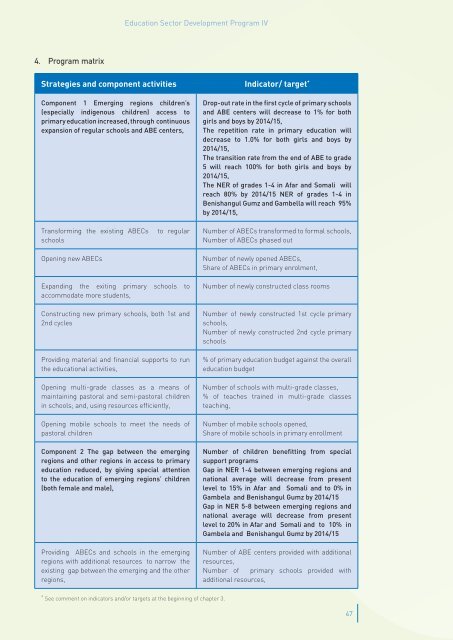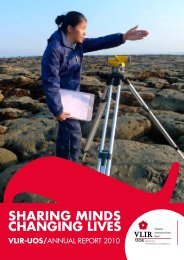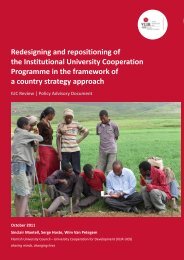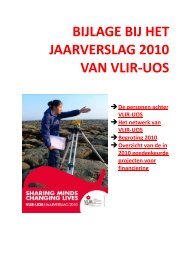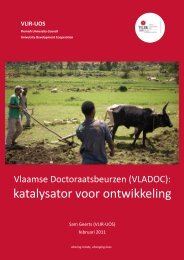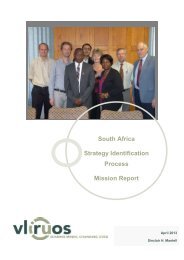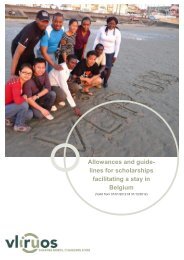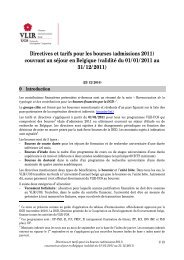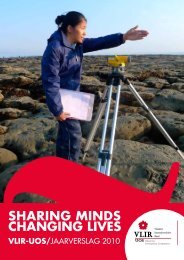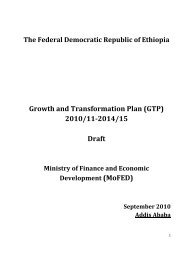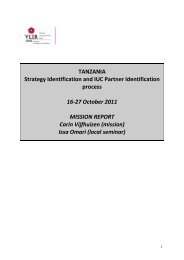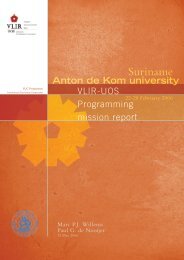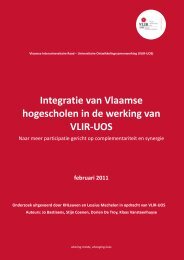Education Sector Development Program - VLIR-UOS
Education Sector Development Program - VLIR-UOS
Education Sector Development Program - VLIR-UOS
Create successful ePaper yourself
Turn your PDF publications into a flip-book with our unique Google optimized e-Paper software.
<strong>Education</strong> <strong>Sector</strong> <strong>Development</strong> <strong>Program</strong> IV<br />
4. <strong>Program</strong> matrix<br />
Strategies and component activities Indicator/ target *<br />
Component 1 Emerging regions children’s<br />
(especially indigenous children) access to<br />
primary education increased, through continuous<br />
expansion of regular schools and ABE centers,<br />
Transforming the existing ABECs to regular<br />
schools<br />
Opening new ABECs<br />
Expanding the exiting primary schools to<br />
accommodate more students,<br />
Constructing new primary schools, both 1st and<br />
2nd cycles<br />
Providing material and financial supports to run<br />
the educational activities,<br />
Opening multi-grade classes as a means of<br />
maintaining pastoral and semi-pastoral children<br />
in schools; and, using resources efficiently,<br />
Opening mobile schools to meet the needs of<br />
pastoral children<br />
Component 2 The gap between the emerging<br />
regions and other regions in access to primary<br />
education reduced, by giving special attention<br />
to the education of emerging regions’ children<br />
(both female and male),<br />
Providing ABECs and schools in the emerging<br />
regions with additional resources to narrow the<br />
existing gap between the emerging and the other<br />
regions,<br />
Drop-out rate in the first cycle of primary schools<br />
and ABE centers will decrease to 1% for both<br />
girls and boys by 2014/15,<br />
The repetition rate in primary education will<br />
decrease to 1.0% for both girls and boys by<br />
2014/15,<br />
The transition rate from the end of ABE to grade<br />
5 will reach 100% for both girls and boys by<br />
2014/15,<br />
The NER of grades 1-4 in Afar and Somali will<br />
reach 80% by 2014/15 NER of grades 1-4 in<br />
Benishangul Gumz and Gambella will reach 95%<br />
by 2014/15,<br />
Number of ABECs transformed to formal schools,<br />
Number of ABECs phased out<br />
Number of newly opened ABECs,<br />
Share of ABECs in primary enrolment,<br />
Number of newly constructed class rooms<br />
Number of newly constructed 1st cycle primary<br />
schools,<br />
Number of newly constructed 2nd cycle primary<br />
schools<br />
% of primary education budget against the overall<br />
education budget<br />
Number of schools with multi-grade classes,<br />
% of teaches trained in multi-grade classes<br />
teaching,<br />
Number of mobile schools opened,<br />
Share of mobile schools in primary enrollment<br />
Number of children benefitting from special<br />
support programs<br />
Gap in NER 1-4 between emerging regions and<br />
national average will decrease from present<br />
level to 15% in Afar and Somali and to 0% in<br />
Gambela and Benishangul Gumz by 2014/15<br />
Gap in NER 5-8 between emerging regions and<br />
national average will decrease from present<br />
level to 20% in Afar and Somali and to 10% in<br />
Gambela and Benishangul Gumz by 2014/15<br />
Number of ABE centers provided with additional<br />
resources,<br />
Number of primary schools provided with<br />
additional resources,<br />
* See comment on indicators and/or targets at the beginning of chapter 3.<br />
47


